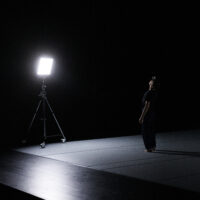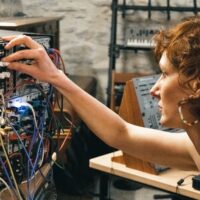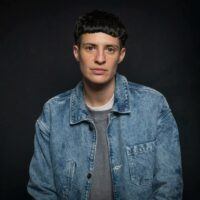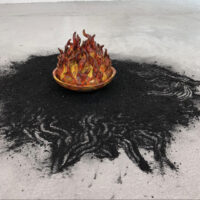Biographie
Léa Drouet est une metteuse en scène, coordinatrice artistique et fondatrice du collectif Vaisseau, une structure de production dédiée à ses créations artistiques. Ses travaux, qui oscillent entre théâtre, installations et performances, cherchent à questionner les liens entre le corps, la mémoire et l’environnement social , souvent en collaboration avec des artistes comme Camille Louis.
Léa Drouet is a director, artistic coordinator and founder of the Vaisseau collective, a production house dedicated to her artistic creations. Her work, oscillating between theatre, installation and performance, seeks to question the links between the body, memory and the social environment, and is often undertaken in collaboration with artists like Camille Louis.
Résidence – Rodéo
RODEO prend la forme d’un concert expérimental à trois voix, entremêlant texte, chant et musique dans un dispositif scénique hybride. L’espace se transforme tour à tour en système nerveux inflammé, marais fumant, site archéologique ou volcan. Les micros y sondent la matière comme des instruments de mesure, pour excaver des récits enfouis. Ces récits sont précis : brouillard mental du Covid long, enfance marquée par le stress, mémoire de la « médina brumeuse » détruite, flammes des voitures brûlées comme symptômes d’injustice sociale, sécheresse de la forêt de Soignes et marais bruxellois en sursis. Le feu et la fumée en sont les motifs centraux, figures d’inflammation et de mémoire. En rapprochant ces histoires séparées sans les confondre, RODEO crée un paysage commun. Corps, société et territoire y résonnent ensemble. Dans la fumée, des récits enfouis se révèlent.
RODEO takes the form of an experimental three-voice concert, intertwining text, song, and music within a hybrid stage device. The space shifts into an inflamed nervous system, a steaming swamp, an archaeological site, or a volcano. Microphones probe matter like measuring instruments, excavating buried stories. These stories are precise: the mental fog of long Covid, a childhood marked by stress, the memory of a destroyed “misty medina,” the flames of burned cars as symptoms of social injustice, the drought of the Sonian forest and Brussels’ swamps at risk. Fire and smoke form the central motifs, figures of inflammation and memory. By bringing these separate stories together without conflating them, RODEO creates a shared landscape. Body, society, and territory resonate as one. In the smoke, buried stories are revealed.



